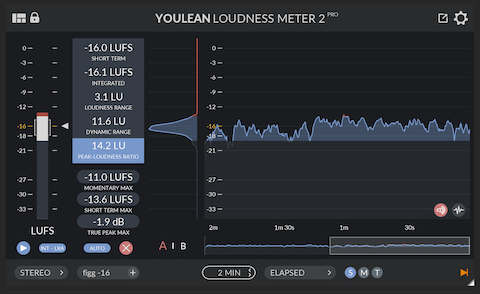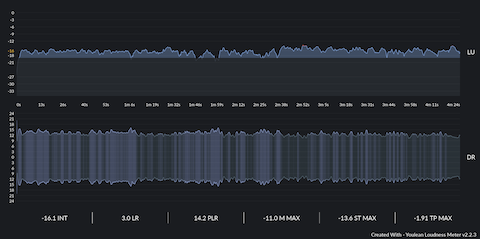I’ve heard a few savvy people refer to the LRA (Loudness Range) descriptor as inherent Dynamic Range. This reference is for the most part inaccurate.
LRA is a threshold gated statistical representation of measured Loudness or variations as such over time. Incorporated Absolute and Relative gating prevents potentially skewed measurements that may result when the passing audio includes sudden instances of impactful amplitude (e.g. gun shots, explosions, etc.) and/or extended periods of silence.
Correlation certainly exists between inherent LRA and Dynamics. In fact – in order to optimize audio for a particular delivery platform, an accurately measured LRA may indicate whether further dynamics manipulation across a segment of audio may be necessary .
PSR and PLR
It is commonplace to acknowledge PSR (Peak to Short Term Loudness Ratio) and PLR (Peak to Loudness Ratio) as accurate indicators of audio dynamics.
PSR is the differential between the measured (ungated) Short Term Loudness and the max. True Peak ceiling. The duration of the averaging window (3 sec.) and the resulting Short Term Loudness measurement relative to the maximum True Peak reflects a near real time representation of playback audio dynamics. High relative PSR values suggest wide dynamics. Conversely low relative PSR values suggest reduced dynamics, excessive limiting, and elevated perceived loudness.
E.g. RT Short Term Loudness: -12 LUFS. Max True Peak -2.0. PSR = 10. As the Short Term Loudness elevates, the differential between it and the True Peak max. decreases thus indicating reduced RT dynamics.
PLR is the differential between measured (gated) Integrated Loudness of (in most cases) an entire audio segment from start to stop and the max True Peak ceiling. In essence PLR represents a long term gated average of inherent dynamics over time.
E.g. measured Integrated Loudness: -16 LUFS. Max True Peak -2.0. PLR = 14. In comparison – if the measured Integrated Loudness checked in at -12 LUFS, the PLR would shift to 10, thus indicating reduced global dynamics and elevated loudness.
LRA vs. Dynamic Range
As far as this vague reference to LRA indicating Dynamic range – consider the following:
A hypothetical mastered (spoken word) Podcast checks in at -16 LUFS with a -2 dBTP max. The inherent PSR (measured in RT using a Loudness Meter) = approx. 10. The PLR = 14, and the measured LRA = 4 LU.
In this example – it is obvious the LRA (4 LU) does not reflect the theoretical dynamic range of the piece. In fact the PSR is the suitable indicator of RT audio dynamics. The PLR represents the global dynamics over the entire duration of the audio segment.
In Conclusion
The LRA descriptor is an algorithmic calculation incorporating gated thresholds. It does not indicate the measured Dynamic Range of a piece of audio. However it is certainly a viable indicator representing the statistical variation of measured Loudness over time.
An elevated spoken word LRA (> 7 LU) may indicate compromised intelligibility, and as noted – the necessity for further DSP processing and re-mastering.
For RT measurement of inherent audio dynamics, use a supported tool to display the running PSR and PLR values. There are various third party options available, such as Dynameter by MeterPlugs, MasterCheck by Nugen Audio, and the Youlean Loudness Meter.
For a (stereo) -16.0 LUFS spoken word Podcast – PLR 15/14 is optimal. Corresponding PSR values will vary based on the attributes of applied dynamics processing.
Incidentally – if you are producing Podcasts professionally, you need to learn how to use a Loudness Meter. It is an essential tool, providing a broad scope of RT descriptors, such as Loudness, LRA, Dynamic Range, and True Peak. A number of meters support offline measurements within certain DAW environments.
-paul.


Do the 3 variables explained in the article (LRA, PSR, PLR) correspond to the 3 range measures present in Youlean (Loudness Range, Dynamic Range, Peak Loudness Ratio. By the way, the names changed in recent versions to: Loudness Range, Realtime Dynamics, Avg. Dynamics (PLR)) ? I can’t find any source that explains what’s that second variable in Youlean, if it’s just PSR.
Allan,
You are correct. RT Dynamics == PSR, pretty much based on the 3sec. averaging. Average Dynamics == PLR, based on long term averaging.
-paul.